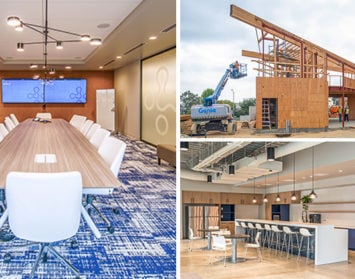Open ceilings are all the rage in office design today. Also referred to as “exposed structure” or “open plenum” ceilings, this architectural trend lends a hip, industrial look to any space, and increases the height of the room to make it feel more spacious. It’s no surprise that more and more tenants are going after the open ceiling look as they undertake tenant improvements.
However, open ceilings can introduce a host of problems in your project if construction isn’t planned with precision. The results of a poorly designed or constructed ceiling may include shoddy acoustics and a look that leaves much to be desired if the overhead mechanical, electrical, and plumbing features aren’t handled properly.
Indeed, exposed ceilings definitely have the potential to look cool, but you’ll need to make sure you spend plenty of time in the planning stages to avoid a headache or an eyesore later. Here are items that absolutely must be considered when designing an open ceiling office.
Planning and Painting
First and foremost, the entire team will need to agree on what the end product should look like before you start your project. You, your architect, and your general contractor all must understand the anticipated look of the overhead space, including exactly what will be visible in the open ceiling. That means you’ll need to plan for what will be stripped or abandoned prior to demolition in order to ensure a clean and smooth look. You won’t want abandoned piping or supports cluttering the newly open ceiling.
You’ll want to select a paint that does not show dust in the exposed ceiling (because it’s tough to dust on top of a duct that’s 20 feet overhead).
Any cables that can be painted need to be, and all cables that cannot be painted because of code requirements or because doing so would void the warranty need to be recognized and accepted by all parties ahead of time; this includes the architect, tenant, general contractor, and subcontractors.
To achieve an uncluttered overhead appearance, all thread supports for mechanical units need to be cut at a uniform elevation after installation, and duct work may need to be insulated or wrapped if ugly flex ducting is prevalent. All structured cabling and free cables should have crisp, sharp turns, and be neatly bundled.
Addressing Acoustical Issues
One of the primary concerns you’ll need to address if you’re planning to have an open ceiling is the issue of acoustics. If not strategically designed, your office could become incredibly noisy, which will lead to distracted employees. Here are a few ways to resolve noise concerns.
Acoustical Ceiling Tile (ACT) provides a Noise Reduction Coefficient (NRC), which is the amount of sound energy absorbed by the ceiling. ACT plays two active roles in the acoustics of a space. First, it acts as a barrier between the loud mechanical units in the ceiling and the people below. Secondly, it reduces noise and echoing by blocking the sound created by employees from traveling to the deck above and bouncing back.
In a space with open ceilings there is no dropped ACT ceiling, which means noise from mechanical equipment overhead will be transmitted throughout the space. In turn, noise created within the space will echo as it bounces off rigid ductwork and the concrete deck above. Therefore, if you decide to leave the ceiling open it is crucial that you add products with sound absorbing qualities in other locations to reduce the excess sound that ACT would have quieted. Soft materials like carpet, acoustical wall panels, and fabric paneled systems furniture (cubicles) will increase sound absorption in the space.
Sound masking systems, also known as white noise systems, while costly, can be well worth the investment. These systems jumble sound as it travels, which increases speech privacy so that staff in open office settings aren’t distracted by their coworkers’ conversations in neighboring workstations. Depending on the deck height, sound masking systems usually cost from $1 per square foot to $2 per square foot.
Another alternative is the use of spray-on applied acoustical applications. These applications range from $2 per square foot to $5 per square foot for plaster based products, and can be directly sprayed or troweled onto the underside of the deck above. Use of these products must be determined early in the design stage as they are messy and require access to the deck. If spray-on acoustical applications are not applied right after demolition, then you will need to arrange for lifts and ladders in order to access the deck while protecting everything below during application. This will increase the cost significantly and slow down construction.
Avoiding HVAC Headaches
When acoustical ceiling tile is removed to expose the ceiling it increases the amount of space the HVAC unit will need to heat and cool. As long as the decision to create an open ceiling is made early on during the design phase, then the mechanical engineer will be able to plan accordingly. However, if the decision is made later, then you could be looking at hefty design costs as well as costs to upsize mechanical equipment or add additional units in order to heat or cool the larger space. This can be extremely expensive. Being aware of these costs upfront can help you make informed, budget-driven design decisions.
There is no doubt that an open ceiling can be hip, cool, and, in many cases, economical. But before you decide to remodel or move into a new space with dreams of opening up the ceiling, you’ll need to do your research. Exposed ceilings aren’t suitable for all types of businesses, nor will they work in all spaces.
If you need help in determining whether an open ceiling is an option in your existing space, or if you’re interested in finding a space where you can create this look, give the Hughes Marino CM team a call. We can assist with site location, and manage your renovation/rebuild from the ground up to ensure you create the office space you crave.
Hughes Marino’s industry leading Construction Management team has unmatched expertise in every type of commercial building project from tenant improvements to ground-up build-to-suits. With decades of experience in California and beyond, our project managers, engineers and LEED APs offer practical insights for the construction management professional.











